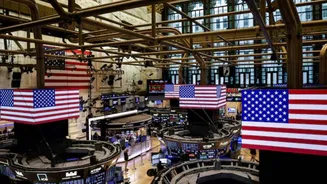Market Reset and Upgrade
Goldman Sachs has shifted its stance on India's equity market, upgrading it to 'overweight' after a 13-month period. This positive revision is largely
attributed to the considerable reduction in foreign investor holdings, creating a more attractive risk-reward profile for the market. The significant outflow of funds, amounting to almost $30 billion since October of the previous year, including $16 billion in the current year, is viewed as a pivotal factor. According to Timothy Moe, co-head of Asia macro research at Goldman Sachs, this shift in investor flows has provided a new and advantageous starting point for investment. Previously, the downgrade was triggered by high valuations and an economic slowdown; however, these conditions have since changed, supporting the upgrade.
Easing Valuations, Stabilization
The shift in Goldman Sachs' perspective is also informed by changes in market fundamentals. Forward valuations have moderated, now hovering around 22 times earnings, making the market more accessible. Furthermore, there are early indicators of economic stabilization. The earnings downgrade cycle, which was a point of concern previously, has flattened, with some sectors even experiencing upgrades. The anticipation for quarterly earnings growth has increased, with expectations of approximately 14% year-on-year, up from the earlier projection of 9%. This improved outlook is a critical element in the firm's positive assessment of the Indian equity market, highlighting a more favorable environment for investment.
Growth Opportunities & Sectors
Goldman Sachs anticipates robust earnings growth in the coming years, forecasting an annual expansion of 13–14%. The firm is particularly optimistic about sectors and themes such as mass consumption, self-sufficiency in defense and energy, the digital economy, and the growth of small and mid-cap companies. The investment team favors specific sectors like consumer durables and financials, initiating a long position on financials relative to the Nifty. These strategic moves reflect a broader investment strategy focused on capturing growth opportunities within the evolving Indian economic landscape. The selection of these sectors aligns with the firm's overall belief in India's strong growth prospects and potential for sustained economic expansion.
Asia Market Perspective
Timothy Moe provides a wider view across the Asian markets, suggesting different investment opportunities. South Korea remains attractive due to its momentum in AI, though it currently trades at 11–12 times earnings. China also stands out, with Goldman Sachs expecting a potential upside of nearly 30% over two years. In contrast, the firm is underweight on Australia and most of ASEAN countries, citing limited catalysts for growth. This comparison illustrates Goldman Sachs' strategic approach to Asian markets, highlighting the relative attractiveness of different regions. The firm's perspective emphasizes the importance of evaluating various market conditions when making investment decisions across the Asia-Pacific region.
Key Drivers & Outlook
While a potential US–India trade deal could positively impact sentiment, the core driver for equity returns will be earnings delivery, according to Moe. With valuations considered full, the focus is on achieving projected earnings. On the macro side, India has managed to keep inflation under control and is continuing gradual fiscal consolidation. Although this leads to lower nominal GDP growth, it supports a more stable economic foundation. The expectation is for the rupee to remain range-bound, indicating that equity returns will primarily be driven by earnings performance rather than currency fluctuations. This points to the firm's conviction in India's fundamentals and the expectation of long-term sustainable growth.















